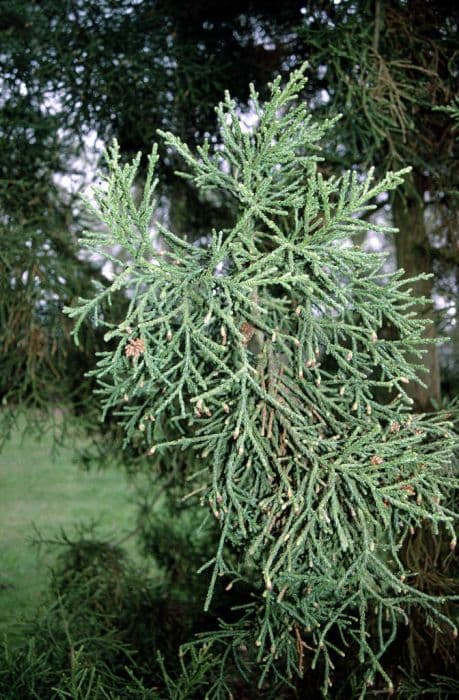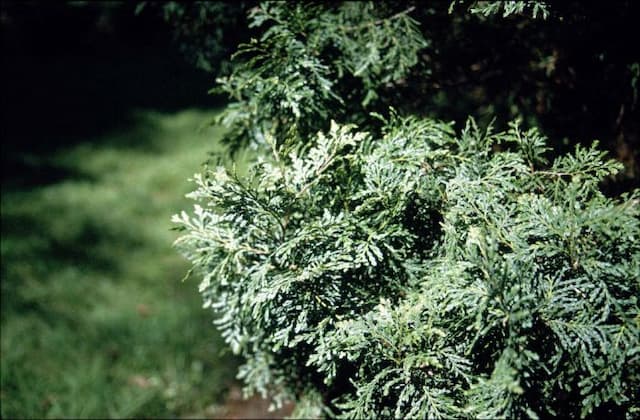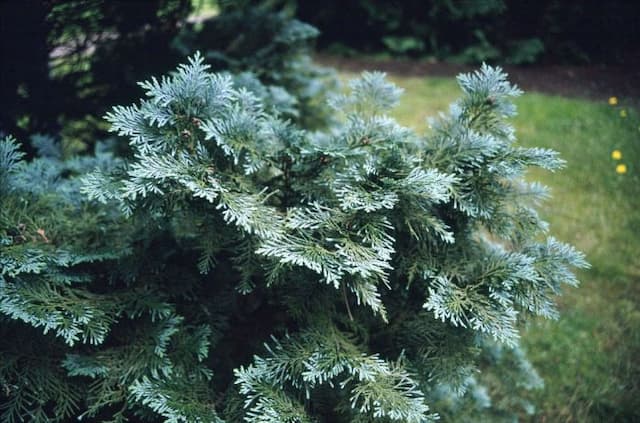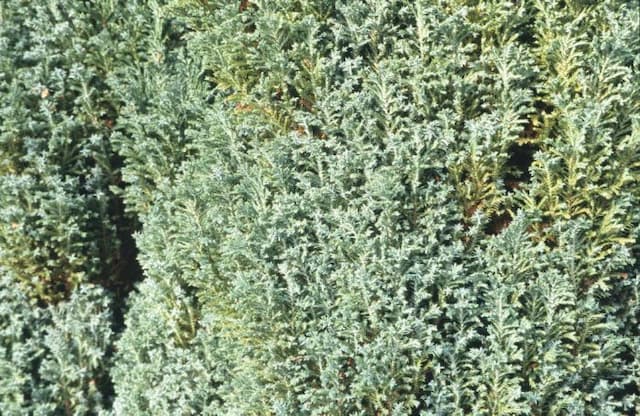Japanese Cedar Cryptomeria japonica 'Little Champion'

ABOUT
The 'Little Champion' is a cultivar of Japanese cedar that is known for its unique and decorative appearance. This evergreen conifer has a compact, globular shape with an overall symmetrical form. The foliage consists of dense, blue-green needles that spiral around the stems, giving it a soft, feathery texture. During the winter months, the needles can take on a slight bronze tint, adding seasonal interest to the plant. These needles emerge from the stems in a radiating pattern that contributes to the plant's full and lush look. The bark of 'Little Champion' is reddish-brown and may become deeply furrowed as the plant matures, providing textural contrast to the smooth needles. Cones may occasionally be produced, being small and globular, although they tend to be inconspicuous against the dense greenery. Overall, the 'Little Champion' cultivar of Japanese cedar is an attractive specimen valued for its aesthetic appeal, with distinct foliage that makes it a standout choice for landscape use.
About this plant
 Names
NamesFamily
Cupressaceae.
Synonyms
Japanese Cedar, Sugi.
Common names
Cryptomeria japonica 'Little Champion'
 Toxicity
ToxicityTo humans
Japanese cedar 'Little Champion' is not typically considered toxic to humans. However, like many plants, ingesting parts of the Japanese cedar in large amounts could potentially cause gastrointestinal discomfort, nausea, vomiting, or diarrhea. There is also a chance of an allergic reaction in sensitive individuals, especially those who are allergic to related plants, but this is not the norm for general contact or casual handling. It is always advisable to exercise caution and prevent the ingestion of plant parts by children or adults, as individual reactions may vary.
To pets
Japanese cedar 'Little Champion' is also not commonly known to be toxic to pets. Ingesting this plant might result in mild gastrointestinal upset for some animals, such as vomiting or diarrhea. But there is no widespread evidence of serious toxicity in pets like cats and dogs. As with any non-food plant material, it is wise to prevent pets from ingesting parts of the plant to avoid any potential digestive troubles. If your pet does consume a considerable amount of Japanese cedar and shows adverse reactions, it is best to consult a veterinarian.
 Characteristics
CharacteristicsLife cycle
Perennials
Foliage type
Evergreen
Color of leaves
Green
Height
3-4 feet (0.91-1.22 meters)
Spread
3-4 feet (0.91-1.22 meters)
Plant type
Shrub
Hardiness zones
5-9
Native area
Japan
Benefits
 General Benefits
General Benefits- Compact Size: 'Little Champion' is a dwarf cultivar, ideal for small gardens and spaces with limited room.
- Ornamental Appeal: Its unique shape and fine, dense foliage add aesthetic value to landscapes.
- Low Maintenance: This variety requires minimal pruning and care once established.
- Drought Tolerance: Once established, it can tolerate periods of dry weather, reducing the need for frequent watering.
- Cold Hardy: Resistant to cold temperatures, making it suitable for a range of climates.
- Evergreen: Provides year-round interest with its evergreen foliage, keeping gardens lively during dull winter months.
- Wildlife Habitat: Offers shelter and nesting sites for birds and other wildlife.
- Soil Adaptability: Can thrive in a variety of soil types, though it prefers moist, well-drained conditions.
 Medical Properties
Medical PropertiesThis plant is not used for medical purposes.
 Air-purifying Qualities
Air-purifying QualitiesThis plant is not specifically known for air purifying qualities.
 Other Uses
Other Uses- Cryptomeria japonica 'Little Champion', also known as Japanese Cedar, can be used as bonsai specimens due to their smaller size and compact growth habit, making them ideal for the art of miniature tree cultivation.
- The wood of Japanese Cedar is aromatic and can be used in the creation of small craft items such as boxes or chests, which can impart a pleasant scent to items stored within them.
- Japanese Cedar can be used in educational settings for teaching about conifer growth, plant anatomy, and plant care, as they are an accessible example of a coniferous tree.
- The fibrous bark of Japanese Cedar has been traditionally used in Japan for making ropes or in textile arts for creating handcrafted items with a distinctive texture.
- Juvenile foliage from Japanese Cedar can be used in floral arrangements, providing a soft, feathery green contrast to other flowers or decorative elements.
- Due to its dense foliage, Japanese Cedar can be planted as a privacy screen or hedge in gardens, offering an aesthetically pleasing and natural barrier.
- The sawdust and shavings from Japanese Cedar woodworking can be used as mulch for garden beds, helping to retain soil moisture and suppress weeds.
- Japanese Cedar needles, when fallen, can be collected and used as a natural potpourri or as an addition to compost piles, because of their slow decomposition rate and rich carbon content.
- As a sound barrier, the dense foliage of Japanese Cedar can help reduce noise pollution when planted along roads or in urban areas.
- Aesthetically, the unique, twisting growth pattern of 'Little Champion' can be used for ornamental topiary art, displaying creativity in shaping and trimming hedges in gardens and landscapes.
Interesting Facts
 Feng Shui
Feng ShuiThe Japanese Cedar is not used in Feng Shui practice.
 Zodiac Sign Compitability
Zodiac Sign CompitabilityThe Japanese Cedar is not used in astrology practice.
 Plant Symbolism
Plant Symbolism- Endurance: The Cryptomeria, commonly known as Japanese Cedar, is an evergreen tree which represents endurance due to its long lifespan and ability to withstand various climates.
- Longevity: Reflecting its potential to live for hundreds of years, the Japanese Cedar symbolizes longevity, often associated with a long and prosperous life.
- Sanctity: In its native land, Japan, the Cryptomeria is often found in sacred groves and Shinto shrines, symbolizing sanctity and a connection to the spiritual world.
 Water
WaterThe Japanese Cedar 'Little Champion' requires consistent moisture but is intolerant of standing water. Initially, water this dwarf conifer deeply once or twice a week, depending on weather conditions, ensuring the soil is damp but not saturated. As the tree matures, reduce watering to when the top 2-3 inches of soil are dry, which typically means watering every 7 to 10 days with about 1-2 gallons per session, depending on the plant size and environmental factors. During hot or dry spells, monitor soil moisture closely and adjust watering as needed. Overwatering and poor drainage can lead to root rot, so it's crucial to maintain a balance.
 Light
LightThe Japanese Cedar 'Little Champion' thrives in a location that receives full sun to partial shade. Ideally, the plant should get at least four to six hours of direct sunlight per day. An east or west-facing spot where morning or late afternoon sun is prevalent is suitable for this conifer. However, in extremely hot climates, some afternoon shade can help protect the plant from excessive heat stress.
 Temperature
TemperatureThe Japanese Cedar 'Little Champion' grows well within a temperature range that typically falls between 40°F and 90°F. However, it can tolerate temperatures down to about 20°F for short periods. The ideal growing conditions for this conifer would be in a region where it experiences moderate temperatures, avoiding extremes of either heat or cold for optimal growth and health.
 Pruning
PruningPruning of the Japanese Cedar 'Little Champion' is often unnecessary unless to shape the plant or remove damaged or dead branches. Light pruning can be done in late winter or early spring before the onset of new growth. It's best to prune sparingly to maintain the plant's natural shape and only when needed. This dwarf conifer typically maintains a compact form without the need for frequent pruning.
 Cleaning
CleaningAs needed
 Soil
SoilJapanese Cedar 'Little Champion' thrives in moist, well-draining soil with a mix that includes organic matter like peat moss or compost. Aim for a soil pH of 5.0 to 7.0 for optimal growth.
 Repotting
RepottingJapanese Cedar 'Little Champion' typically requires repotting every few years as it outgrows its container. It's best to repot in spring before the new growth starts.
 Humidity & Misting
Humidity & MistingJapanese Cedar 'Little Champion' is tolerant of a range of humidity levels but prefers moderate humidity; misting can help maintain appropriate levels if needed.
 Suitable locations
Suitable locationsIndoor
Provide bright light, avoid dry heat sources.
Outdoor
Full sun to partial shade, shelter from strong winds.
Hardiness zone
5-9 USDA
 Life cycle
Life cycleThe life of Cryptomeria japonica 'Little Champion', commonly known as the 'Little Champion' Japanese Cedar, begins with seed germination, which requires a moist environment and may take several weeks. After germination, the seedling grows through a juvenile phase where it establishes roots and foliage, becoming more tolerant to variations in moisture and temperature. It then enters a phase of rapid growth where it develops its characteristic conical shape and dense foliage. As it matures, the 'Little Champion' enters a reproductive phase, producing small, globular cones that contain seeds for dispersal. As a relatively slow-growing cultivar, it may take several years to reach its mature size of 3 to 4 feet tall. Finally, in its mature stage, the 'Little Champion' requires minimal maintenance, aside from occasional pruning to maintain shape and encourage denser growth.
 Propogation
PropogationPropogation time
Spring-Early Summer
Cryptomeria japonica 'Little Champion', commonly known as Dwarf Japanese Cedar, is generally propagated through semi-hardwood cuttings. The most suitable time for taking cuttings is during the late summer or early fall when the wood has matured slightly but is not fully hardened. A cutting should be about 4 to 6 inches (10 to 15 centimeters) long with several sets of needles. To propagate, one would take the cutting, remove the needles from the lower half, and dip the cut end into a rooting hormone powder or solution to enhance root development. Then, the prepared cutting is inserted into a well-draining potting mix, making sure that the nodes where the needles were removed are buried as roots tend to form from these areas. The potting media should be kept moist, and the cuttings should be placed in a location with indirect sunlight and ideally under a humidity dome or in a greenhouse to maintain high humidity around the cuttings. Roots typically develop within a few months, after which the young plants can be potted up individually and gradually acclimated to less protected environments.









